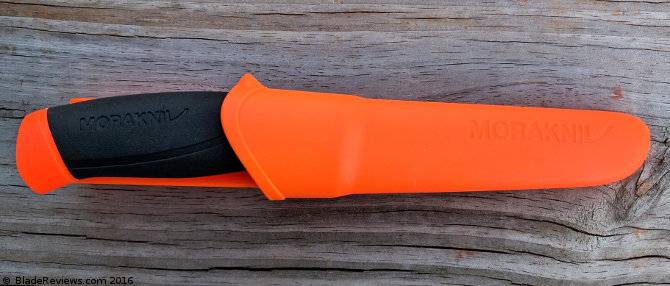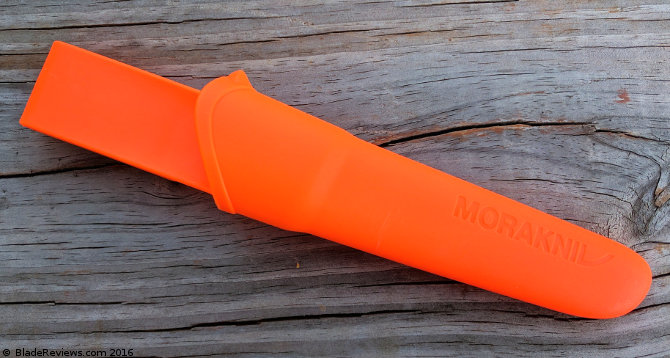This post contains affiliate links. We may get paid an affiliate commission if you buy something or take an action after clicking one of the links on this web page.
I’ll always be a folding knife guy at heart, but recently I’ve been on a fixed blade kick. I never thought they would appeal to me, but I’ve come to appreciate fixed blades of all shapes and sizes. And in a nice little fluke of symmetry, just as my appreciation of folding knives began with an affordable, European everyman’s knife, the fixed blade that opened my eyes is similarly affordable, European, and populist: the Mora Companion.
The Mora Companion, and Mora in general, has a complicated reputation in the knife world. This complication stems from its intersection with the hardcore outdoorsman / survivalist / bushcrafter communities. Whether or not it was designed for the kind of applications these guys put it through is unclear (and Mora’s own literature on the subject is vague), but it has become a point of contention amongst enthusiasts, who tend to think it is an indispensable tool or a sham of a knife.
I approached this review with no significant outdoors experience, no previous Mora experiences, and no fixed blade preferences. The Companion thoroughly impressed me. I put this through an especially wide array of cutting chores and it never flagged, never failed to impress me. This is a beautifully simple tool. It was an impulse purchase for me, and the best one I have ever made.
(For the record, the model I reviewed is a standard Companion with the 12C27 stainless steel blade.)
General Dimensions and Blade Details
The Companion has a 4” blade, a 4.5” handle, and an overall length of about 8.5”. It comes with a plastic friction fit sheath. Combined, the knife and sheath weigh just about 4 oz. Like all Mora knives, the Companion is made in Mora, Sweden. The Companion is exactly the right size for the sort of general outdoor tasks you would call on it to do.

Mora has a near-perfect rendition of the drop point here. One thing that is hard to notice in photographs is the balance between straight and curved edge. It may not look like it, but the blade is divided, length-wise into equal portions of curved and straight edge. Some blades favor one or the other but here, the balance is exact. Whether you’re slicing, roll cutting, push – or pull-cutting, you’re going to have enough length of the edge you need for the job. Brilliant.
Steel is 12C27 – a great blade steel, especially at the price. There are plenty of proponents of the carbon steel Moras out there. I’m sure that the carbon steel is great, but I abhor rust and I abhor having to worry about my knives so I went with the stainless. It’s kept a little soft at 57-58 Rockwell, which is probably good given that it might be pressed into more demanding tasks.

The Scandi grind is a traditional element of Scandinavian knife culture, present and accounted for on the Companion. It’s a little reductive, but the way I think of a Scandi grind is as a sabre grind with an extremely small edge bevel. Scandi grinds are renowned for their woodworking ability, and my experience with the Companion reinforces this. This knife took huge, even bites out of a block of basswood. Beyond this, the general geometry of the edge made the knife excel at just about everything. I cut woods, thick plastic ties, paper, cardboard, and produce. The Companion went through everything with ease, and I never fought to push it through media until it was almost totally dull.
The first time I sharpened my Companion I just went along the tiny edge bevel and had great results, although I understand now this isn’t the traditional method. If you watch videos on how to sharpen a Scandi-ground knife, they tell you that the primary bevel sets your sharpening angle. This means that you should never have to reprofile a Scandi-ground knife, even after years of use. It also means that if you’re using something like a Sharpmaker you may have to configure it for freehand sharpening.

The second time I sharpened the Companion, I set it along the primary bevel as I was supposed to. It worked well, although I marred up the mirror finish on the knife a bit. I was using a dry diamond plate instead of a wet stone, so this may have had something to do with it.
Handle and Ergonomics
The Companion’s handle is made from plastic, with a TPE-like wrap around the center swell. It’s great, plain and simple. The palm swell is exactly my style, and there is just the slightest amount of Coke bottling to fill the hand. The downturn at the butt of the knife and the guard at the front are both gentle enough to preclude any issues of finger crowding. This is a great, task neutral handle.

Some designers overengineer their handles, with embellishments like finger grooves, parrot beaks, palm swells, different traction inserts for different parts of the handle, jimping, thumb ramps – eventually it just becomes too much. The Companion is wonderful in the hand without being overdesigned. I wouldn’t call it understated so much as simply stated: this is just a knife, plain and simple. The handle is here so you can use the thing, so go out and use it, however you want.

Sheath
The sheath is your standard plastic friction fit Mora affair. Although it didn’t move me to my core, I like this sheath. The plastic, while not as handsome as leather, doesn’t look any worse to my eye than nylon and is very lightweight and durable. There’s a drainage hole at the bottom to let out accumulated moisture, and I like that the belt clip doesn’t require me to take my belt off and loop it through. You simply pry it open far enough to slide over your belt, and you’re golden. It almost works like an oversized pocket clip.

Another small feature that I found surprisingly handy was the thumb ramp on the corner of the sheath. You can push off it with your thumb to disengage the Companion from the sheath with ease, and it helps index when you’re putting the knife away.
Mora Companion – Final Thoughts
I’ve gone this long in the review without addressing the Companion’s price, so I’d like to do so now.
A lot of people say or think that the Companion is a good knife for the price. I don’t believe in good knives for the price. There are good knives, and there are good values. You can pay too much for a good knife, but you can never say a bad knife is a good value.
I think that reviewers need to address the cost of all the products they review, because value – what you get for what you pay – is an intrinsic part of good design. It contextualizes design decisions. This is why we’re okay with AUS-8 on a $25 knife but less thrilled when we get it for $80 – it doesn’t make a knife a worse knife, but it makes it less well-designed, and thus less attractive as a possible purchase.
If I paid $75 for the Companion, I’d still tell you that it was a good knife, but I would take issue with design choices relative to its price, and it wouldn’t get a recommendation.
- BUSHCRAFT KNIFE: The perfect all-in-one knife for outdoor enthusiasts, this outdoor knife makes an ideal camping knife, backpacking knife, fishing knife, hiking knife, or survival knife
- PREMIUM BLADE: 0.08-inch thick hardened Sandvik 12C27 stainless steel knife blade stays sharp longer than carbon steel and is less prone to rust; Ideal for carving, food prep, and cutting tinder
- HIGH-FRICTION HANDLE: Made with an ergonomic polymer handle with a soft friction grip and finger guard, this knife is safe and efficient for use in all weather conditions
- PROTECTIVE POLYMER SHEATH: Easy-to-clean plastic sheath comes equipped with a belt clip, so you can easily attach your knife to a belt or rucksack
- SPECIFICATIONS: Blade thickness: 0.08 inch (2.0 mm), blade length: 4.1 inches (104 mm), total length: 8.5 inch (217 mm), net weight with sheath: 3.9 ounces (110 g)
I recommend purchasing the Mora Companion at Amazon. Please consider that purchasing anything through any of the links on this website helps support BladeReviews.com, and keeps the site going. As always, any and all support is greatly appreciated. Thank you very much.



JOHN, YOU PROBABLY DON’T HAVE THE STAINLESS STEEL VERSION. TRY A LITTLE BARKEEPER’S FRIEND OR SOMETHING LIKE THAT IF THE PATINA BOTHERS YOU. P.S. DON’T DRINK THE WATER.
Dan
I love Moras and recommend everybody keep a stainless companion in the trunk of their car next to the spare tire. It’s like 15 bucks, will last forever, and may save your life.
It’s not a bad knife, it feels good in the hand, simple design, a lot of pluses. It’s sharp to start. But the it’s so soft. Simple stamp in even soft plastic the blade has major delens. The edge is gone. So disappointing. I was so excited and never have last so much like for a knife. Sorry. But my scale is piece of crap. Won’t stand up to any actual tour door use. The price is good. But this is one time that good price doesn’t give you quality.
So disappointed.